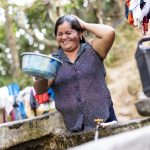Impact Evaluation Measures More Than Water
Most of us hear the word test and want to run the other way. Especially in the summer! But this one is different. It’s not about passing or failing, it’s about listening, learning, and improving how we deliver safe water.
Over the next 12 months, a team of local enumerators—trained and guided by researchers from UC Berkeley and the National Autonomous University of Honduras (UNAH)—will be conducting regular water quality testing (think regular E. coli checks and chlorine monitoring), paired with surveys at the household and Water Board levels, exploring everything from how families collect and use water to how confident communities feel managing their water and water treatment systems.
The study spans 300 communities across 6 municipalities in the Comayagua and Cortes departments—communities with untreated water, and where Cova has recently made an introduction. With data collected before and after chlorinators are introduced, and at regular intervals over the next year once our circuit rider model is in full swing, the study will help us answer some big questions: Is the circuit rider model effectively providing safe water? Is it building local capacity? While not every community will choose to use a chlorinator, understanding barriers, reservations, and motivations is also one of the study’s key goals.
It isn’t about passing or failing. It is about rigorous data collection, listening, learning, and making sure Cova’s circuit rider model impact is real, measurable, and lasting. Because when it comes to safe water, the only score we care about is how many families can drink safely, today and for years to come.
Click here to read more about past studies and peer reviewed articles. While we scale up our model, we believe it is important to frequently measure our impact and course correct if/as necessary to ensure we are always providing the highest level of impact.





